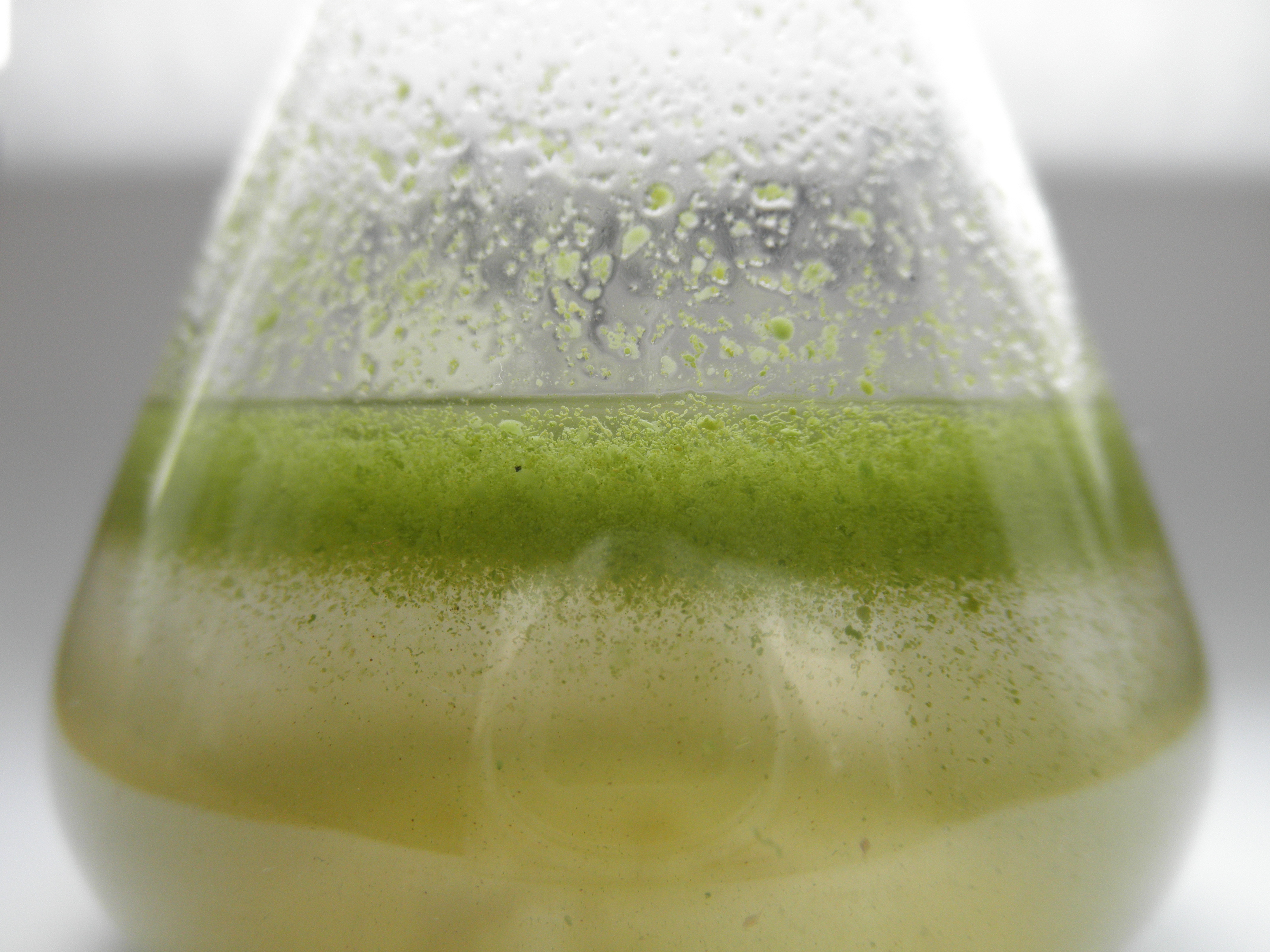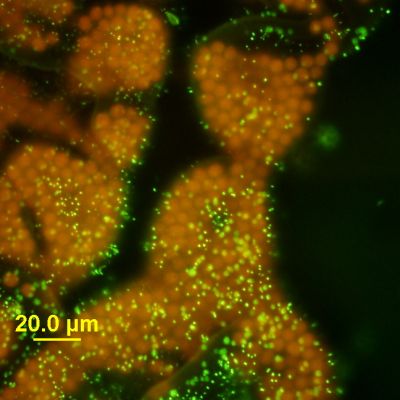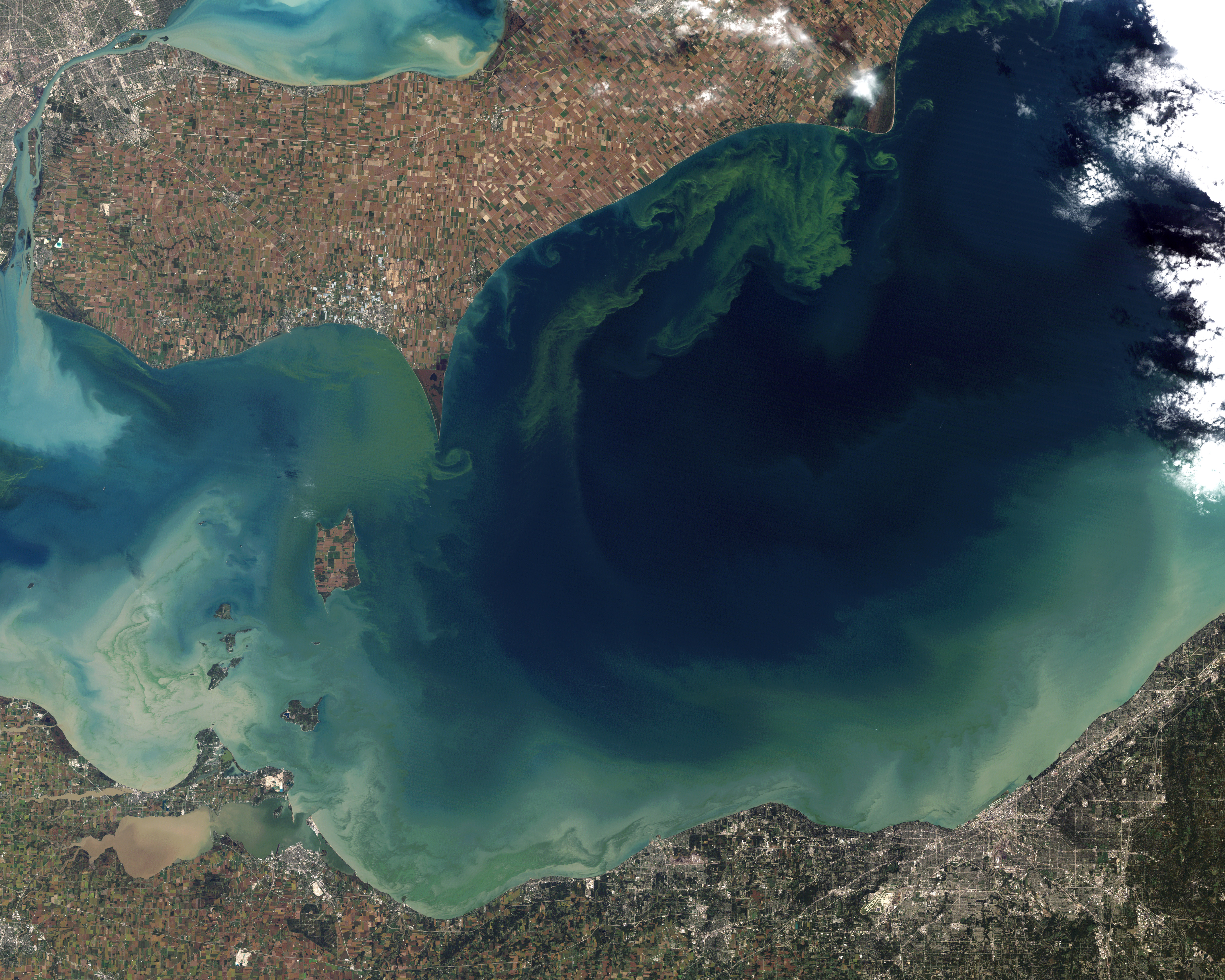Microcystis on:
[Wikipedia]
[Google]
[Amazon]
''Microcystis'' is a genus of freshwater
 The genus ''Microcystis'' derives from the Greek ''mikros'' (small) + ''kystis'' (bladder).
As the etymological derivation implies, ''Microcystis'' is characterized by small cells (a few
The genus ''Microcystis'' derives from the Greek ''mikros'' (small) + ''kystis'' (bladder).
As the etymological derivation implies, ''Microcystis'' is characterized by small cells (a few
 ''Microcystis'' is capable of producing large surface blooms through a combination of rapid division and
''Microcystis'' is capable of producing large surface blooms through a combination of rapid division and
 In North America, ''Microcystis'' blooms have caused issues in numerous freshwater systems over the last two decades. These include large lakes (Erie, Okeechobee) and small regional water masses like Ohio's Grand Lake St Marys. In 2014, detection of the microcystin toxin in treated water of Toledo (OH) resulted in a shutdown of the water supply to more than 400,000 residents. The breakthrough of the toxin in the system was linked to the presence of a virus that lysed cells and released the toxin out of particles into the dissolved phase.
In North America, ''Microcystis'' blooms have caused issues in numerous freshwater systems over the last two decades. These include large lakes (Erie, Okeechobee) and small regional water masses like Ohio's Grand Lake St Marys. In 2014, detection of the microcystin toxin in treated water of Toledo (OH) resulted in a shutdown of the water supply to more than 400,000 residents. The breakthrough of the toxin in the system was linked to the presence of a virus that lysed cells and released the toxin out of particles into the dissolved phase.
cyanobacteria
Cyanobacteria ( ) are a group of autotrophic gram-negative bacteria that can obtain biological energy via oxygenic photosynthesis. The name "cyanobacteria" () refers to their bluish green (cyan) color, which forms the basis of cyanobacteri ...
that includes the harmful algal bloom
A harmful algal bloom (HAB), or excessive algae growth, sometimes called a red tide in marine environments, is an algal bloom that causes negative impacts to other organisms by production of natural algae-produced toxins, water deoxygenation, ...
-forming '' Microcystis aeruginosa''.
Over the last few decades, cyanobacterial blooms caused by eutrophication
Eutrophication is a general term describing a process in which nutrients accumulate in a body of water, resulting in an increased growth of organisms that may deplete the oxygen in the water; ie. the process of too many plants growing on the s ...
have become a major environmental problem in aquatic ecosystems worldwide, and the most representative and harmful cyanobacteria
Cyanobacteria ( ) are a group of autotrophic gram-negative bacteria that can obtain biological energy via oxygenic photosynthesis. The name "cyanobacteria" () refers to their bluish green (cyan) color, which forms the basis of cyanobacteri ...
is ''Microcystis''.'''' ''Microcystis'' blooms have increased due to global climate change, spanning six continents and causing increased health risks to wildlife and humans.
This article will address the conditions for the growth of ''Microcystis,'' physical characteristics, ecology
Ecology () is the natural science of the relationships among living organisms and their Natural environment, environment. Ecology considers organisms at the individual, population, community (ecology), community, ecosystem, and biosphere lev ...
, geographic distribution'','' and health risks of ''Microcystis.''
Conditions for ''Microcystis''
During the summer in temperate systems, ''Microcystis'' can rise to form blooms on the water surface. These blooms, linked toanthropogenic
Anthropogenic ("human" + "generating") is an adjective that may refer to:
* Anthropogeny, the study of the origins of humanity
Anthropogenic may also refer to things that have been generated by humans, as follows:
* Human impact on the enviro ...
nutrient loading, occur generally when water temperatures exceed 15 °C. But, as the global climate
Climate is the long-term weather pattern in a region, typically averaged over 30 years. More rigorously, it is the mean and Statistical dispersion, variability of Meteorology, meteorological variables over a time spanning from months to milli ...
changes, the intensity and occurrence of the blooms is expected to increase.
Physical characteristics
 The genus ''Microcystis'' derives from the Greek ''mikros'' (small) + ''kystis'' (bladder).
As the etymological derivation implies, ''Microcystis'' is characterized by small cells (a few
The genus ''Microcystis'' derives from the Greek ''mikros'' (small) + ''kystis'' (bladder).
As the etymological derivation implies, ''Microcystis'' is characterized by small cells (a few micrometers
The micrometre (Commonwealth English as used by the International Bureau of Weights and Measures; SI symbol: μm) or micrometer (American English), also commonly known by the non-SI term micron, is a unit of length in the International System ...
in diameter), possessing gas-filled vesicles (also lacking individual sheaths). The cells are usually organized into colonies
A colony is a territory subject to a form of foreign rule, which rules the territory and its indigenous peoples separated from the foreign rulers, the colonizer, and their '' metropole'' (or "mother country"). This separated rule was often or ...
(aggregations of which are visible with the naked eye) that begin in a spherical shape, losing coherence to become perforated or irregularly shaped over time. These colonies are bound by a thick mucilage
Mucilage is a thick gluey substance produced by nearly all plants and some microorganisms. These microorganisms include protists which use it for their locomotion, with the direction of their movement always opposite to that of the secretion of ...
composed of complex polysaccharide
Polysaccharides (), or polycarbohydrates, are the most abundant carbohydrates found in food. They are long-chain polymeric carbohydrates composed of monosaccharide units bound together by glycosidic linkages. This carbohydrate can react with wat ...
compounds, including xylose
Xylose ( , , "wood") is a sugar first isolated from wood, and named for it. Xylose is classified as a monosaccharide of the aldopentose type, which means that it contains five carbon atoms and includes an aldehyde functional group. It is deriv ...
, mannose
Mannose is a sugar with the formula , which sometimes is abbreviated Man. It is one of the monomers of the aldohexose series of carbohydrates. It is a C-2 epimer of glucose. Mannose is important in human metabolism, especially in the glycosylatio ...
, glucose
Glucose is a sugar with the Chemical formula#Molecular formula, molecular formula , which is often abbreviated as Glc. It is overall the most abundant monosaccharide, a subcategory of carbohydrates. It is mainly made by plants and most algae d ...
, fucose
Fucose is a hexose deoxy sugar with the chemical formula C6H12O5. It is found on ''N''-linked glycans on the mammalian, insect and plant cell surface. Fucose is the fundamental sub-unit of the seaweed polysaccharide fucoidan. The α(1→3) l ...
, galactose
Galactose (, ''wikt:galacto-, galacto-'' + ''wikt:-ose#Suffix 2, -ose'', ), sometimes abbreviated Gal, is a monosaccharide sugar that is about as sweetness, sweet as glucose, and about 65% as sweet as sucrose. It is an aldohexose and a C-4 epime ...
, and rhamnose, among other compounds.
The coloration of the protoplast
Protoplast (), is a biology, biological term coined by Johannes von Hanstein, Hanstein in 1880 to refer to the entire cell, excluding the cell wall. Protoplasts can be generated by stripping the cell wall from plant, bacterium, bacterial, or f ...
is a light blue-green, appearing dark or brown due to optical effects of gas-filled vesicles.
Ecology
 ''Microcystis'' is capable of producing large surface blooms through a combination of rapid division and
''Microcystis'' is capable of producing large surface blooms through a combination of rapid division and buoyancy
Buoyancy (), or upthrust, is the force exerted by a fluid opposing the weight of a partially or fully immersed object (which may be also be a parcel of fluid). In a column of fluid, pressure increases with depth as a result of the weight of t ...
regulation by production of gas-filled vesicles. In nature, ''Microcystis'' can exist as single cells or in large colonies containing many cells. Their ability to regulate buoyancy is one of the keys to their dominance of eutrophic waters, by optimally positioning themselves within the photic zone
The photic zone (or euphotic zone, epipelagic zone, or sunlight zone) is the uppermost layer of a body of water that receives sunlight, allowing phytoplankton to perform photosynthesis. It undergoes a series of physical, chemical, and biological ...
in a stable water column.
Because they can form large surface blooms, they are thought to be able to out-compete other phytoplankton
Phytoplankton () are the autotrophic (self-feeding) components of the plankton community and a key part of ocean and freshwater Aquatic ecosystem, ecosystems. The name comes from the Greek language, Greek words (), meaning 'plant', and (), mea ...
by monopolizing light in the photic zone.
''Microcystis'' spp. are also capable of efficient uptake of phosphate
Phosphates are the naturally occurring form of the element phosphorus.
In chemistry, a phosphate is an anion, salt, functional group or ester derived from a phosphoric acid. It most commonly means orthophosphate, a derivative of orthop ...
and nitrogen; they are believed to be strongly influenced by nitrogen to phosphorus ratios ( N:P ratio). ''Microcystis'' cells are also efficient at assimilating carbon from their environment; during large blooms, rampant photosynthesis can drive the pH of communities to > 9.0. Recent efforts have suggested a combination of effective carbon-concentrating mechanisms and a potential ability to use urea as both a carbon and nitrogen source allows ''Microcystis'' to persist under these high-pH conditions.
Yuhao Song et al evaluated the relationship between phosphorus sources and ''Microcystis''. This study was essential in building an understanding of the ecological risks of cyanobacterial blooms. These scientists were able to find the following relationships between ''Microcystis'' and phosphorus sources: interactions between phosphorus and ''Microcystis'' determine the outbreak of ''Microcystis'' blooms, different phosphorus conditions affect ''Microcystis'' growth and resistance to harmful factors, and ''Microcystis'' can drive the distribution of phosphorus sources in aquatic environments. They also concluded that the understanding of endogenous phosphorus should be broadened and more attention should be focused on metabolic processes related to ''Microcystis'' cells to provide more support and understanding in control and management of ''Microcystis'' blooms.
Geographic distribution
The toxic cyanobacterial blooms are expected to become more widespread with climate change because water stratification and increasing temperature favor bloom-forming cyanobacteria. ''Microcystis'' is widespread in temperate and subtropical lakes, reservoirs, and rivers in at least 108 countries on six continents. In South Africa,Hartbeespoort Dam
Hartbeespoort Dam (also known as ''Harties'') is an arch type dam situated in the North West Province of South Africa. It lies in a valley to the south of the Magaliesberg mountain range and north of the Witwatersberg mountain range, about 35 ki ...
is highly impacted by ''Microcystis'' because of elevated phosphate and nitrate levels flowing from the sewers of Johannesburg, one of the few cities in the world that straddles a continental watershed divide, so lies upstream of major dams and rivers.
 In North America, ''Microcystis'' blooms have caused issues in numerous freshwater systems over the last two decades. These include large lakes (Erie, Okeechobee) and small regional water masses like Ohio's Grand Lake St Marys. In 2014, detection of the microcystin toxin in treated water of Toledo (OH) resulted in a shutdown of the water supply to more than 400,000 residents. The breakthrough of the toxin in the system was linked to the presence of a virus that lysed cells and released the toxin out of particles into the dissolved phase.
In North America, ''Microcystis'' blooms have caused issues in numerous freshwater systems over the last two decades. These include large lakes (Erie, Okeechobee) and small regional water masses like Ohio's Grand Lake St Marys. In 2014, detection of the microcystin toxin in treated water of Toledo (OH) resulted in a shutdown of the water supply to more than 400,000 residents. The breakthrough of the toxin in the system was linked to the presence of a virus that lysed cells and released the toxin out of particles into the dissolved phase.
Health risks
Cyanobacteria can produceneurotoxin
Neurotoxins are toxins that are destructive to nervous tissue, nerve tissue (causing neurotoxicity). Neurotoxins are an extensive class of exogenous chemical neurological insult (medical), insultsSpencer 2000 that can adversely affect function ...
s and hepatotoxin
A hepatotoxin (''Greek language, Gr., hepato = liver'') is a toxic chemical substance that damages the liver.
It can be a adverse effect, side-effect, but hepatotoxins are also found naturally, such as microcystins and pyrrolizidine alkaloids, or ...
s, such as microcystin and cyanopeptolin. The potent hepatotoxin poses a risk to those who use impaired water resources for drinking water supplies, recreational activities, and fisheries. Microcystins are the only cyanotoxins that the World Health Organization has set drinking and recreational water standards.
Countless fatalities and severe poisonings of livestock, wildlife, and pets have been caused by ''Microcystis'' blooms. Microcystin-containing ''Microcystis'' has also caused human illness via direct consumption of drinking water and accidental ingestion of water or skin contact during recreational use of water. The most severe case of human poisoning took place in Brazil in 1996, when a bloom of ''Microcystis'' in a drinking reservoir caused 56 fatalities.
''Microcystis'' has also been reported to produce a compound (or compounds) that can have endocrine-disrupting effects. In 2018, the Great Lakes Center for Fresh Waters and Human Health was founded at Bowling Green State University
Bowling Green State University (BGSU) is a Public university, public research university in Bowling Green, Ohio, United States. The main academic and residential campus is south of Toledo, Ohio. The university has nationally recognized progr ...
with a focus on problems associated with ''Microcystis'' blooms in the Great Lakes. Under the leadership of inaugural director George S. Bullerjahn, the center engages scientists from nine institutions across six states, and is supported by combined funding from the National Science Foundation and National Institute of Environmental Health Sciences.
Species
''Microcystis'' species include: *'' Microcystis aeruginosa'' *'' Microcystis argentea'' *'' Microcystis botrys'' *'' Microcystis elongata'' *'' Microcystis flos-aquae'' *'' Microcystis holsatica'' *'' Microcystis lutescens'' *'' Microcystis marina'' *'' Microcystis pallida'' *'' Microcystis panniformis'' *'' Microcystis salina'' *'' Microcystis thermalis'' *'' Microcystis viridis'' *'' Microcystis wesenbergii''See also
*'' Pandorina'' (Analogy
Analogy is a comparison or correspondence between two things (or two groups of things) because of a third element that they are considered to share.
In logic, it is an inference or an argument from one particular to another particular, as oppose ...
)
*Lake Erie
Lake Erie ( ) is the fourth-largest lake by surface area of the five Great Lakes in North America and the eleventh-largest globally. It is the southernmost, shallowest, and smallest by volume of the Great Lakes and also has the shortest avera ...
*Lake Okeechobee
Lake Okeechobee ( ) is the largest freshwater lake in the U.S. state of Florida. It is the List of largest lakes of the United States by area, eighth-largest natural freshwater lake among the 50 states of the United States and the second-largest ...
* Hartebeestpoort Dam
References